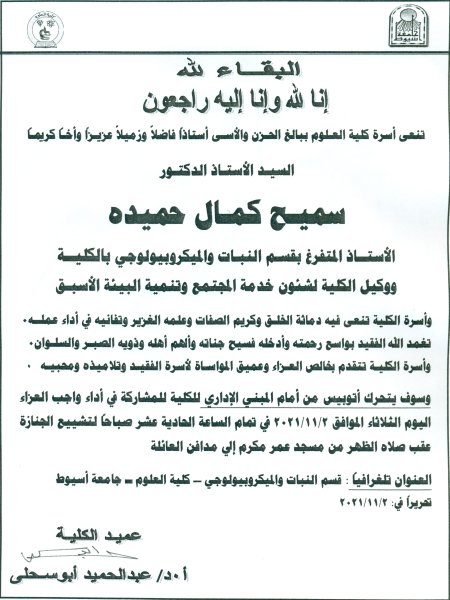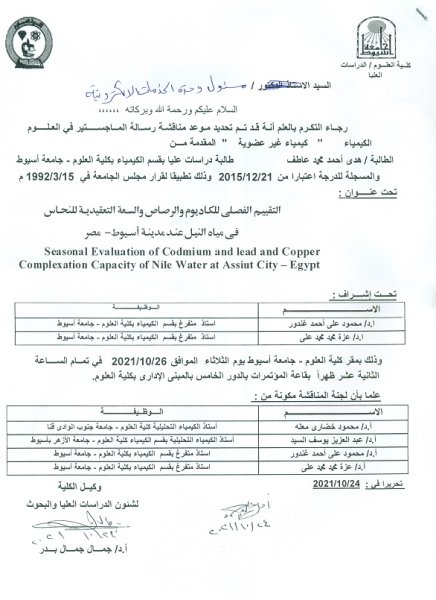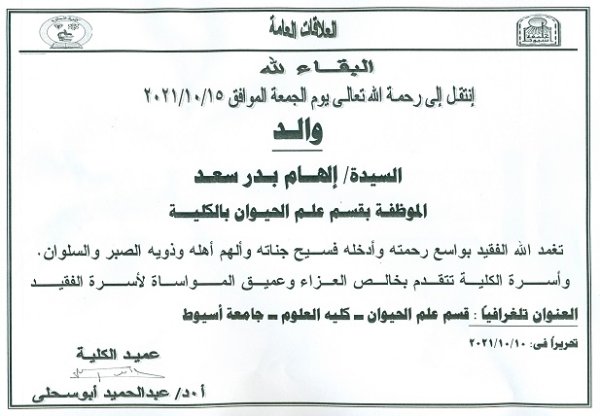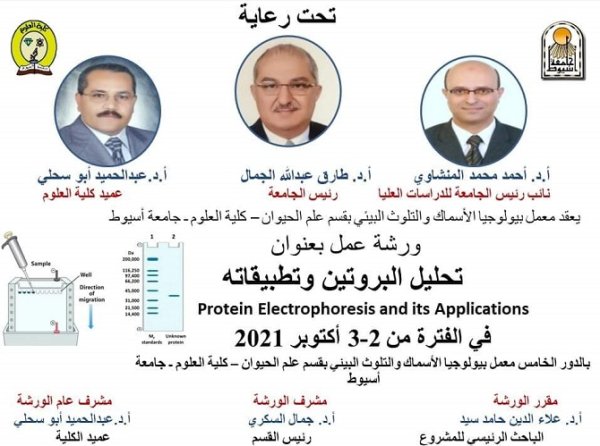
Do you have any questions? (088) 2345643 - 2412000 sci_dean@aun.edu.eg
Condolences
Announcement
Announcement
Condolences
Announcement for student
التسجيل الالكتروني لجداول الفصل الدراسي الاول لعام 2021-2022
يبدا التسجيل الالكتروني لجداول الفصل الدراسي الاول 2021-2022 يوم الاربعاء 6-10-2021 الي يوم الخميس 7-10-2021
وحذف واضافة المقررات الكترونيا يوم الجمعة 8-10-2021 من خلال الرابط :
http://sci-credit-reg.com/

Protein Electrophoresis and its Applications workshops
On the dielectric behaviors of Zn1−x−yFexMyO ceramics for nonlinear optical and solar cell devices
Ac dielectric measurements of Zn1−x−yFexMyO samples with diferent M, x and y were made against frequency (f) up to 10 MHz. It is found that addition of Cu beside Fe in ZnO decreased the porosity and average size of grains, whereas they are increased by addition of Ni in place of Cu. The real and imaginary parts of dielectric constant (ε′, ε″) and dielectric loss (tanδ) are generally decreased by Fe, followed by an increase/decrease for (Fe+Ni)/(Fe+Cu) samples. Furthermore, the conduction is electronic below 10 kHz for all samples, but it is changed to hole as f increases above 10 kHz. Generally, the binding energy Wm, minimum hopping distance (Rmin) and density of states at Fermi level N(EF) are slightly increased by Fe, followed by a decrease for the co-doped samples. Interestingly, the N(Ef ) of the Zn0.9Fe.1O (S2) sample is sharply increased with f, goes to optimum at 28.7 Hz and then decreases. In addition, the F-factor, for solar cell design, was increased by increasing f, and it has the samples order of (Fe), (Fe+Ni), (Zn) and (Fe+Cu). A single semicircle could be obtained from the Cole–Cole plot and the impedance of grain Z\ (G) and that of grain boundaries Z\ (GB) are increased by Fe, followed by an increase/decrease for (Fe+Cu)/(Fe+Ni) samples. The radius of arc increases for Fe and (Fe+Cu) samples, revealing a decrease in capacitance, while vice versa for (Fe+Ni) samples. The arcs seem to be centered below the Z\ axis, indicating non-Debye relaxation of dipoles. These outcomes indicate that Fe and (Fe+Ni) samples shift the ZnO dielectric medium to higher values, and it is strongly recommended with Fe sample for solar cell design. In contrast, the (Fe+Cu) samples are recommended for high-frequency nonlinear optical devices due to their poor dielectric medium. To the best of our knowledge, the present systematic investigation may not be reported elsewhere.
The role of flavonoids in inhibiting IL-6 and inflammatory arthritis
Rheumatoid arthritis (RA) is a chronic autoimmune disease that primarily affects the synovial joints. RA has well-known clinical manifestations and can cause progressive disability and premature death along with socioeconomic burdens. Interleukin-6 (IL-6) has been implicated in the pathology of RA where it can stimulate pannus formation, osteoclastogenesis, and oxidative stress. Flavonoids are plant metabolites with beneficial pharmacological effects, including anti-inflammatory, antioxidant, antidiabetic, anticancer, and others. Flavonoids are polyphenolic compounds found in a variety of plants, vegetables, and fruits. Many flavonoids have demonstrated anti-arthritic activity mediated mainly through the suppression of pro-inflammatory cytokines. This review thoroughly discusses the accumulate data on the role of flavonoids on IL-6 in RA.
Evidence for Upper Cretaceous seismites in the Abu Tartur area, Western Desert, Egypt
Upper Cretaceous tidal-flat sediments of the Abu Tartur region, Western Desert of Egypt, contain a variety of soft-
sediment deformation structures (SSDSs) in the Mut Member of the Quseir Formation and the overlying Duwi
Formation. Here, we document recognition of a set of SSDSs characterized by complex morphology and large
size. The SSDS include: 1) water-escape structures, 2) minor recumbent, chevron, and slump folds, 3) syn-
sedimentary minor faults, 4) neptunian dykes, 5) regular ball-and-pillow structures, flattened pseudo-nodules,
and load casts, 6) syn-sedimentary undulations, 7) fractures and joints, 8) sand injectites, and 9) autoclastic
breccia and brecciated siderite clasts. The dimensions of the SSDSs range from a few centimeters to several
decimeters. Both extensional and contractional forces appear to have been involved in development of these
structures. A detailed analysis of facies relationships, combined with consistent orientations of SSDSs and the
regional tectonics of the target area suggests earthquakes as the triggering mechanism for sediment deformation and large-scale mass failure. The deformed strata are consistent with most of the well-known criteria of typical seismites. Thus, syn-sedimentary liquefaction was identified as the primary driving force in most of the observed deformation horizons for these Upper Cretaceous SSDSs in the Abu Tartur area.






